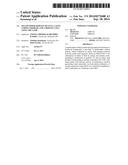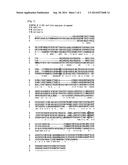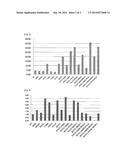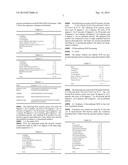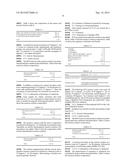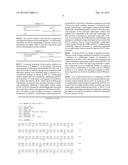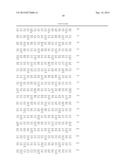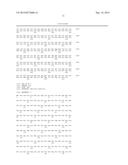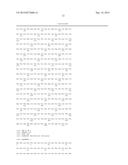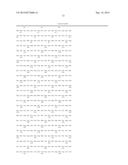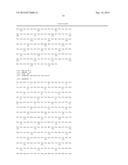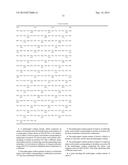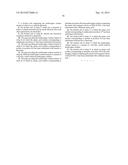Patent application title: MULTICOPPER OXIDASE MUTANT, A GENE CODING THEREOF, AND A BIOFUEL-CELL USING THE SAME
Inventors:
Takahiro Kusumegi (Toyota-Shi, JP)
Kumi Terada (Toyota-Shi, JP)
IPC8 Class: AH01M816FI
USPC Class:
429401
Class name: Chemistry: electrical current producing apparatus, product, and process fuel cell, subcombination thereof, or method of making or operating biochemical fuel cell
Publication date: 2014-09-18
Patent application number: 20140272608
Abstract:
A multicopper oxidase mutant having improved resistance to imidazole
compounds is provided. A multicopper oxidase mutant, which comprises an
amino acid sequence derived from the amino acid sequence shown in SEQ ID
NO: 2 by substitution of either or both an amino acid residue
corresponding to methionine at position 157 and an amino acid residue
corresponding to proline at position 414 with a different amino acid and
has activity of catalyzing a reaction generating water molecules via
four-electron reduction of oxygen molecules using ABTS
(2,2'-azinobis(3-ethylbenzoline-6-sulfonate)) as a substrate is provided.Claims:
1. A multicopper oxidase mutant, which comprises an amino acid sequence
derived from the amino acid sequence of a multicopper oxidase shown in
SEQ ID NO: 2 by substitution of either or both an amino acid residue
corresponding to methionine at position 157 and an amino acid residue
corresponding to proline at position 414 with a different amino acid and
has activity of catalyzing a reaction generating water molecules via
four-electron reduction of oxygen molecules using ABTS
(2,2'-azinobis(3-ethylbenzoline-6-sulfonate)) as a substrate.
2. The multicopper oxidase mutant of claim 1, in which the amino acid residue corresponding to methionine at position 157 has been substituted with leucine.
3. The multicopper oxidase mutant of claim 1, in which the amino acid residue corresponding to proline at position 414 has been substituted with leucine or threonine.
4. The multicopper oxidase mutant of claim 1, which is a mutant of a Bacillus subtilis-derived multicopper oxidase.
5. The multicopper oxidase mutant of claim 2, in which an amino acid residue corresponding to histidine at position 90 in the multicopper oxidase comprising the amino acid sequence shown in SEQ ID NO: 2 has been substituted with a different amino acid.
6. A gene encoding the multicopper oxidase mutant of claim 1.
7. A biofuel cell comprising the multicopper oxidase mutant of claim 1 as a cathode electrode.
8. The biofuel cell of claim 7, which has a structure in which a cathode electrode and an anode electrode face each other separated by an electrolyte.
9. The biofuel cell of claim 8, wherein the electrolyte comprises imidazole compounds.
10. The gene encoding the multicopper oxidase mutant of claim 6, in which the amino acid residue corresponding to methionine at position 157 has been substituted with leucine.
11. The gene encoding the multicopper oxidase mutant of claim 6, in which the amino acid residue corresponding to proline at position 414 has been substituted with leucine or threonine.
12. The gene encoding the multicopper oxidase mutant of claim 6, which the multicopper oxidase mutant is a mutant of a Bacillus subtilis-derived multicopper oxidase.
13. The gene encoding the multicopper oxidase mutant of claim 6, in which an amino acid residue corresponding to histidine at position 90 in the multicopper oxidase comprising the amino acid sequence shown in SEQ ID NO: 2 has been substituted with a different amino acid.
14. The biofuel cell of claim 7, in which the amino acid residue corresponding to methionine at position 157 has been substituted with leucine.
15. The biofuel cell of claim 7, in which the amino acid residue corresponding to proline at position 414 has been substituted with leucine or threonine.
16. The biofuel cell of claim 7, which the multicopper oxidase mutant is a mutant of a Bacillus subtilis-derived multicopper oxidase.
17. The biofuel cell of claim 7, in which an amino acid residue corresponding to histidine at position 90 in the multicopper oxidase comprising the amino acid sequence shown in SEQ ID NO: 2 has been substituted with a different amino acid.
Description:
TECHNICAL FIELD
[0001] The present invention relates to a multicopper oxidase mutant having a substitution mutation at a position corresponding to a given position in a multicopper oxidase, a gene encoding such multicopper oxidase mutant, and a biofuel cell using the multicopper oxidase mutant.
BACKGROUND ART
[0002] Multicopper oxidases (bilirubin oxidases) are proteins that have the four copper atoms necessary for enzyme activity within the molecules. They serve as oxidoreductases for catalyzing a reaction generating water molecules via four-electron reduction of oxygen molecules using electrons removed from an arbitrary substrate. As described in Patent Literature 1 to 4, multicopper oxidases are used for cathode electrodes of biofuel cells or used as electrode materials for a variety of biosensors. In addition, as suggested in Patent Literature 1 to 3, there have been attempts to introduce at least one amino acid substitution mutation into a multicopper oxidase so as to modify the functions of the enzyme in order to prevent reduction of enzyme activity during immobilization, improve thermostability of the enzyme, or reduce the reaction overpotential.
[0003] Biofuel cells are also referred to as "enzyme fuel cells" in which electrical energy is generated in a chemical reaction caused by an enzyme for use of electrical energy. As in cases of conventional batteries, biofuel cells have structures in which a cathode electrode and an anode electrode face each other separated by an electrolyte, and alcohol (e.g., methanol or ethanol) or sugar (e.g., glucose) is used as fuel. In addition, as described in Patent Literature 5, it is known that imidazole compounds can be used as electrolytes.
[0004] However, when an imidazole compound is used as an electrolyte, the compound causes degeneration of an enzyme (e.g., the above multicopper oxidase) used in a biofuel cell, resulting in reduction of enzyme activity. As shown in Patent Literature 5, there are examples of use an enzyme in the presence of imidazole compounds. However, it can be expected that the enzyme may not exhibit sufficient activity. The output of the fuel cells also depends on various factors except for the enzyme. Therefore, development of an enzyme having resistance to imidazole compounds improves the output of the fuel cells.
CITATION LIST
Patent Literature
[0005] PTL 1: JP Patent Publication (Kokai) No. 2009-158480 A
[0006] PTL 2: JP Patent Publication (Kokai) No. 2008-161178 A
[0007] PTL 3: JP Patent Publication (Kokai) No. 2010-183857 A
[0008] PTL 4: JP Patent Publication (Kokai) No. 2009-044997 A
[0009] PTL 5: JP Patent Publication (Kokai) No. 2009-158458 A
SUMMARY OF INVENTION
Technical Problem
[0010] In view of the above circumstances, an object of the present invention is to provide a multicopper oxidase mutant for which reduction of enzyme activity can be prevented even in the presence of imidazole compounds; that is to say, a multicopper oxidase mutant having improved resistance to imidazole compounds. Another object of the present invention is to provide a gene encoding such multicopper oxidase and a biofuel cell using the same.
Solution to Problem
[0011] As a result of intensive studies to achieve the above object, the present inventors have found that a substitution mutation of an amino acid at a given position in a multicopper oxidase allows prevention of reduction in multicopper oxidase activity caused by imidazole compounds, making it possible to remarkably improve resistance of the multicopper oxidase to the imidazole compounds. This has led to the completion of the present invention.
[0012] Specifically, the multicopper oxidase mutant of the present invention comprises an amino acid sequence derived from the amino acid sequence shown in SEQ ID NO: 2 by substitution of either or both an amino acid residue corresponding to methionine at position 157 and an amino acid residue corresponding to proline at position 414 with a different amino acid and has activity of catalyzing a reaction generating water molecules via four-electron reduction of oxygen molecules using ABTS (2,2'-azinobis(3-ethylbenzoline-6-sulfonate)) as a substrate.
[0013] In addition, the amino acid residue corresponding to methionine at position 157 is preferably substituted with leucine and the amino acid residue corresponding to proline at position 414 is preferably substituted with leucine or threonine in the multicopper oxidase mutant of the present invention.
[0014] More preferably, an amino acid residue corresponding to histidine at position 90 is further substituted with a different amino acid in the amino acid sequence of the multicopper oxidase mutant of the present invention in which an amino acid residue corresponding to methionine at position 157 has been substituted with a different amino acid. In such case, it is particularly preferable for an amino acid residue corresponding to histidine at position 90 to be substituted with arginine.
[0015] Moreover, in the most preferable embodiment of the multicopper oxidase mutant of the present invention, the amino acid residue corresponding to methionine at position 157 is substituted with a different amino acid, the amino acid residue corresponding to proline at position 414 is substituted with a different amino acid, and the amino acid residue corresponding to histidine at position 90 is substituted with a different amino acid. Particularly preferably, in such case, the amino acid residue corresponding to methionine at position 157 is substituted with leucine, the amino acid residue corresponding to proline at position 414 is substituted with leucine, and the amino acid residue corresponding to histidine at position 90 is substituted with arginine.
[0016] Further, the multicopper oxidase mutant gene of the present invention comprises a polynucleotide encoding the above multicopper oxidase mutant. Specifically, the multicopper oxidase mutant gene of the present invention encodes a protein which comprises an amino acid sequence derived from the amino acid sequence shown in SEQ ID NO: 2 by substitution of either or both an amino acid residue corresponding to methionine at position 157 and an amino acid residue corresponding to proline at position 414 with a different amino acid and has activity of catalyzing a reaction generating water molecules via four-electron reduction of oxygen molecules using ABTS (2,2'-azinobis(3-ethylbenzoline-6-sulfonate)) as a substrate.
[0017] Furthermore, the above multicopper oxidase mutant is used for a cathode electrode in the biofuel cell of the present invention. Specifically, the biofuel cell of the present invention has a structure in which a cathode and an anodeface each other separated by an electrolyte and uses the multicopper oxidase mutant of the present invention as a catalyst for the positive electrode. Here, the multicopper oxidase mutant can be immobilized to an electrode by a conventionally known technique. In addition, an electrolyte used herein preferably comprises imidazole compound(s).
Advantageous Effects of Invention
[0018] The multicopper oxidase mutant of the present invention has a novel substitution mutation and thus has significantly improved resistance to imidazole compounds over the corresponding unmutated multicopper oxidase. Reduction of multicopper oxidase activity can be prevented even in the presence of imidazole compounds in a biofuel cell using the multicopper oxidase mutant of the present invention. This allows long-term maintenance of excellent battery characteristics.
BRIEF DESCRIPTION OF DRAWINGS
[0019] FIG. 1 is a characteristic diagram showing results of a comparison of amino acid sequences of conventionally known multicopper oxidases for which the present invention can be used.
[0020] FIG. 2 is a characteristic diagram showing residual activity levels of multicopper oxidase mutants treated with imidazole compounds.
[0021] FIG. 3 is a characteristic diagram showing specific activity levels of multicopper oxidase mutants.
DESCRIPTION OF EMBODIMENTS
[0022] The present invention is described in detail with reference to the drawings.
[0023] <Multicopper Oxidase>
[0024] The multicopper oxidase mutant of the present invention comprises an amino acid sequence obtained by substituting a given amino acid residue with a different amino acid in a multicopper oxidase. Here, the multicopper oxidase is not particularly limited as long as it is a protein having the four copper atoms necessary for enzyme activity within the molecule and has the activity of catalyzing a reaction generating water molecules via four-electron reduction of oxygen molecules using electrons removed from an arbitrary substrate (hereinafter referred to as multicopper oxidase activity). Multicopper oxidases use a variety of substances as substrates that allow them to exhibit the above multicopper oxidase activity. An example of such a substrate is ABTS (2,2'-azinobis(3-ethylbenzoline-6-sulfonate)). In this specification, the term "multicopper oxidase activity" may refer to activity of catalyzing a reaction generating water molecules via four-electron reduction of oxygen molecules with electrons removed from ABTS. Another example of the substrate is bilirubin. In addition, a multicopper oxidase that has the activity of catalyzing a reaction generating two biliverdin molecules and water molecules from bilirubin and oxygen molecules using bilirubin as a substrate is referred to as "bilirubin oxidase."
[0025] Examples of other substrates that can be used include oxidoreductive organic or inorganic compounds such as ferrocene, ferricyanide-alkaline metals (e.g., potassium ferricyanide, lithium ferricyanide, and sodium ferricyanide) or alkyl substitutes thereof (e.g., methyl substitute, ethyl substitute, and propyl substitute), phenazine methosulfate, p-benzoquinone, 2,6-dichlorophenolindophenol, methylene blue, beta-naphthoquinone-4-potassium sulfonate, phenazine ethosulfate, vitamin K, viologen, and Os complexes (e.g., the Os complexes described in JP Patent Publication (Kohyo) No. 2003-514823 A and JP Patent Publication (Kohyo) No. 2003-514924 A). In addition to the above, examples of substrates include: metal complexes mainly comprising metal elements such as Os, Fe, Ru, Co, Cu, Ni, V, Mo, Cr, Mn, Pt, and W or metal ions thereof; quinones such as quinone, benzoquinone, anthraquinone, and naphthoquinone; and heterocyclic compounds such as viologen, methylviologen, and benzylviologen. Further, a variety of compounds described as electron transfer mediators immobilized to a cathode (positive electrode) in JP Patent Publication (Kokai) No. 2011-124090 A and JP Patent Publication (Kokai) No. 2009-245930 A can be used as substrates.
[0026] A multicopper oxidase may be a plant-derived enzyme, an animal-derived enzyme, or a microorganism-derived enzyme. Examples of a microorganism-derived multicopper oxidase include a Bacillus subtilis-derived multicopper oxidase and a Myrothecium verrucaria-derived multicopper oxidase.
[0027] The gene nucleotide sequence of a Bacillus subtilis-derived multicopper oxidase and the amino acid sequence of a multicopper oxidase encoded by the gene are shown in SEQ ID NOS: 1 and 2, respectively. In addition, the amino acid sequence of a multicopper oxidase encoded by a Myrothecium verrucaria-derived multicopper oxidase gene is shown in SEQ ID NO: 3. An N-terminal-deficient-Myrothecium-verrucaria-derived multicopper oxidase is disclosed with accession no: 3ABC_B in a known sequence database. The amino acid sequence of the Myrothecium verrucaria-derived multicopper oxidase with accession no. 3ABC_B is shown in SEQ ID NO: 4.
[0028] A multicopper oxidase that can be used in the present invention is not particularly limited to a multicopper oxidase comprising the amino acid sequence shown in SEQ ID NO: 2, 3, or 4. For example, it may be a multicopper oxidase comprising an amino acid sequence derived from the amino acid sequence shown in SEQ ID NO: 2, 3, or 4 by deletion, substitution, addition, or insertion of one or more amino acids (other than amino acid residues to be substituted described in detail below) and having multicopper oxidase activity. Here, the term "one or more amino acids" refers to, for example, 1 to 30 amino acids, preferably 1 to 20 amino acids, more preferably 1 to 10 amino acids, further preferably 1 to 5 amino acids, and particularly preferably 1 to 3 amino acids. Deletion, substitution, or addition of amino acids can be carried out by modifying a gene encoding the multicopper oxidase by a method known in the art. For gene mutation, a conventionally known method such as the Kunkel method or the Gapped duplex method or a method in accordance therewith can be used. For example, a mutagenesis kit (e.g., Mutant-K or Mutant-G (product name; TAKARA)) using a site-specific mutation induction method or an LA PCR in vitro Mutagenesis series kit (product name; TAKARA) can be used for mutagenesis.
[0029] In addition, according to the present invention, a protein which comprises an amino acid sequence having, for example, 85% or more, preferably 90% or more, and more preferably 95% or more, and most preferably 98% or more sequence similarity to the amino acid sequence shown in SEQ ID NO: 2, 3, or 4 and has multicopper oxidase activity can be used as a multicopper oxidase. Here, the value of sequence similarity refers to a value that can be found based on default setting using a computer program equipped with a BLAST algorithm.
[0030] Further, a protein, which has multicopper oxidase activity and is encoded by a polynucleotide that hybridizes under stringent conditions to a polynucleotide complementary to a part or the whole of the nucleotide sequence shown in SEQ ID NO: 1, can be used as a multicopper oxidase in the present invention. Here, hybridization under stringent conditions means binding that is maintained during washing with 2×SSC at 60 degrees C. Hybridization can be carried out by a conventionally known method such as the method described in J. Sambrook et al. Molecular Cloning, A Laboratory Manual, 2nd Ed., Cold Spring Harbor Laboratory (1989).
[0031] A multicopper oxidase used herein is not limited to the above Bacillus-subtilis-derived or Myrothecium-verrucaria-derived multicopper oxidase. A multicopper oxidase from any organism species can be used in the present invention. For example, the amino acid sequences of multicopper oxidases from various types of species can be identified by searching a database containing gene information.
[0032] According to the present invention, any term can be used instead of the term "multicopper oxidase" for an enzyme as long as the enzyme has the above activity. For example, a known term such as laccase, bilirubin oxidase, multicopper oxidase, or blue copper oxidase can be used.
[0033] <Substitution Mutation>
[0034] The multicopper oxidase mutant of the present invention is obtained by substituting a given amino acid residue of the amino acid sequence of any of the above multicopper oxidases from various types of organism species such that it has resistance to imidazole compounds, which is significantly improved more than that of the multicopper oxidase before amino acid substitution. Here, an amino acid residue to be substituted can be identified with a numeral determined by reckoning the number of amino acid residues from the N terminus of Bacillus subtilis-derived multicopper oxidase comprising the amino acid sequence shown in SEQ ID NO: 2. However, the specific numeral for an amino acid residue to be substituted that is identified based on the amino acid sequence shown in SEQ ID NO: 2 would vary depending on the multicopper oxidase type. Therefore, "an amino acid residue at position X in the amino acid sequence shown in SEQ ID NO: 2" does not correspond to an amino acid residue at position X in a multicopper oxidase comprising an amino acid sequence that differs from the amino acid sequence shown in SEQ ID NO: 2, resulting in a different numeral for an amino acid residue to be substituted.
[0035] In the case of an amino acid sequence that differs from the amino acid sequence shown in SEQ ID NO: 2, an amino acid residue which corresponds to a given amino acid residue in the amino acid sequence shown in SEQ ID NO: 2 can be identified by multiple alignment analysis of a plurality of amino acid sequences, including the amino acid sequence shown in SEQ ID NO: 2. Multiple alignment analysis is not particularly limited. A person skilled in the art can readily carry out multiple alignment analysis using the CLUSTAL W (1.83) multiple sequence alignment program (available at the National Institute of Genetics (NIC) for DDBJ (http://clustalw.ddbj.nig.ac.jp/top-j.html)). If pairwise alignment analysis is used for alignment of the amino acid sequence shown in SEQ ID NO: 2 and a different amino acid sequence, an amino acid residue that corresponds to a given amino acid residue in the amino acid sequence shown in SEQ ID NO: 2 can be identified in the different amino acid sequence.
[0036] FIG. 1 shows the results of multiple alignment analysis for a Bacillus subtilis-derived multicopper oxidase (SEQ ID NO: 2) and Myrothecium verrucaria-derived multicopper oxidases (SEQ ID NOS: 3 and 4). In the multiple alignment shown in FIG. 1, the 1st and 2nd lines show the Myrothecium verrucaria-derived multicopper oxidases, and the 3rd line shows the Bacillus subtilis-derived multicopper oxidase. In addition to such specific multicopper oxidases, other multicopper oxidases can be subjected to multiple alignment analysis. The position of a given amino acid residue can be identified based on the Bacillus subtilis-derived multicopper oxidase (SEQ ID NO: 2). Hereinafter, an amino acid to be substituted is described based on the amino acid sequence shown in SEQ ID NO: 2; that is to say, the amino acid sequence of the Bacillus subtilis-derived multicopper oxidase. Note that a numeral that denotes the position of an amino acid would vary depending on the multicopper oxidase type, as described above. The multicopper oxidase mutant of the present invention includes a multicopper oxidase mutant that has a substitution mutation of an amino acid residue and a multicopper oxidase mutant derived from such multicopper oxidase mutant by further substitution mutation of an amino acid residue, as described below.
[0037] <Multicopper Oxidase Mutant>
[0038] The multicopper oxidase mutant of the present invention comprises an amino acid sequence derived from the amino acid sequence shown in SEQ ID NO: 2 by substitution of either or both an amino acid residue corresponding to methionine at position 157 and an amino acid residue corresponding to proline at position 414 with a different amino acid. In FIG. 1, an amino acid residue corresponding to methionine at position 157 and an amino acid residue corresponding to proline at position 414 are boxed. FIG. 1 shows that methionine at position 157 in the amino acid sequence shown in SEQ ID NO: 2 is also conserved in the Myrothecium verrucaria-derived multicopper oxidase.
[0039] Here, a different amino acid is not particularly limited. It can be any amino acid as long as a multicopper oxidase mutant has significantly improved resistance to imidazole compounds over the corresponding unmutated multicopper oxidase. The resistance to imidazole compounds can be evaluated based on residual activity determined after treatment (e.g., at 90 degrees C. for 30 minutes) in a solution containing imidazole compound(s) for a certain period of time. In addition, the improvement of resistance to imidazole compounds indicates that the residual activity of a multicopper oxidase mutant is statistically significantly greater than that of the unmutated wild-type multicopper oxidase. Enzyme activity of a multicopper oxidase mutant or that of the corresponding unmutated (unsubstituted) multicopper oxidase can be adequately determined by a conventionally known method. For instance, the residual activity of a multicopper oxidase can be determined by reacting the multicopper oxidase in a pH-adjusted buffer solution comprising 2,2'-azinobis(3-ethylbenzothiazoline-6-sulfonic acid) (ABTS) ammonium salt as a substrate and determining changes in the absorbance of the reaction product of ABTS. Accordingly, it can be determined whether or not substitution mutation of a given amino acid is effective for improving resistance to imidazole compounds.
[0040] More specifically, regarding the above substitution mutation, it is particularly preferable for the amino acid residue corresponding to methionine at position 157 and the amino acid residue corresponding to proline at position 414 to be substituted with leucine and leucine or threonine, respectively. In addition, a multicopper oxidase mutant may have either or both the substitution mutation of methionine at position 157 and the substitution mutation of proline at position 414. In either case, the multicopper oxidase mutant has higher resistance to imidazole compounds than the corresponding unmutated multicopper oxidase.
[0041] More preferably, an amino acid residue corresponding to histidine at position 90 is further substituted with a different amino acid in the amino acid sequence of the multicopper oxidase mutant of the present invention, in which an amino acid residue corresponding to methionine at position 157 has been substituted with a different amino acid. Particularly preferably, the amino acid residue corresponding to histidine at position 90 is substituted with arginine. In addition, a multicopper oxidase mutant that has a substitution mutation of histidine at position 90 alone has resistance to imidazole compounds comparable to that of the wild-type multicopper oxidase. However, such substitution mutation of histidine at position 90 enhances the resistance to imidazole compounds improved as a result of the above substitution mutation of methionine at position 157. Specifically, a multicopper oxidase double-mutant that has a substitution mutation of methionine at position 157 and a substitution mutation of histidine at position 90 has remarkably improved resistance to imidazole compounds over a multicopper oxidase mutant that has a substitution mutation of methionine at position 157 alone.
[0042] Specific examples of preferable amino acids serving as substituents are described above. However, such amino acids serving as substituents are not limited to the above examples. As described in Reference (1) ("McKee's Biochemistry," Third Edition, Chapter 5, Amino acid, Peptide, Protein, 5.1 Amino acid, Atsushi Ichikawa (editor), Shinichi Fukuoka (translator), Ryosuke Sone (publisher), published by Kagaku-Dojin Publishing Co., Inc., ISBN4-7598-0944-9)), it is well-known that amino acids are classified in accordance with side chains having similar properties (i.e., chemical properties or physical size). Also, it is well-known that, in molecular evolution, substitution of amino acid residues, which are classified into a given group, takes place at high frequency while protein activity is retained. Based on such concept, Reference (2) (Henikoff S., Henikoff J. G., Amino-acid substitution matrices from protein blocks, Proc. Natl. Acad. Sci. USA, 89, 10915-10919 (1992)) proposes in FIG. 2 that the amino acid residue substitution scoring matrix (BLOSUM), and this is extensively used. Reference (2) is based on the principle that substitution of amino acids having similar side chain chemical properties imposes little influence on proteins in terms of structural or functional changes. According to References (1) and (2), side chain groups of amino acids in terms of the multiple alignment can be determined based on indicators such as chemical properties and physical sizes. This is indicated as a group of amino acids having a score of 0 or larger and preferably as a group of amino acids having a score of 1 or larger in the scoring matrix (BLOSUM) disclosed in Reference (2).
[0043] Based on the above findings, amino acids having similar properties can be classified as a member of one of the eight groups described below. Therefore, after substitution, each amino acid is preferably classified as a member of the group that includes the corresponding amino acid described above. For example, methionine at position 157 in a Bacillus subtilis-derived multicopper oxidase is preferably substituted with leucine. Alternatively, the methionine residue may be substituted with isoleucine, methionine, or valine, which is classified as a member of the following group, of which leucine is also a member: 1) Group of hydrophobic aliphatic amino acids. Similarly, proline at position 414 in a Bacillus subtilis-derived multicopper oxidase is preferably substituted with leucine or threonine. Alternatively, the proline residue may be substituted with isoleucine, methionine, or valine, which is classified as a member of the following group, of which leucine is also a member: 1) Group of hydrophobic aliphatic amino acids. Or, it may be substituted with serine, which is classified as a member of the following group, of which threonine is also a member: 2) Group having hydroxymethylene groups. Further, histidine at position 90 in a Bacillus subtilis-derived multicopper oxidase is preferably substituted with arginine. Alternatively, the histidine residue may be substituted with lysine, which is classified as a member of the following group, of which arginine is also a member: 4) Group of basic amino acids.
[0044] 1) Group of Hydrophobic Aliphatic Amino Acids (ILMV Group)
[0045] This is a group of amino acids having hydrophobic aliphatic side chains selected from among the neutral and non-polar amino acids described in Reference (1), which is composed of V (Val, valine), L (Leu, leucine), I (Ile, isoleucine), and M (Met, methionine). Among amino acids that are classified as neutral and non-polar amino acids according to Reference (1), FGACWP is not included in "the group of hydrophobic aliphatic amino acids" for the following reasons. That is, G (Gly, glycine) and A (Ala, alanine) are smaller than methyl groups and have small non-polar effects. Also, C (Cys, cysteine) occasionally plays a key role in S--S bonds and forms a hydrogen bond with an oxygen atom or nitrogen atom. Further, side chains of F (Phe, phenylalanine) and W (Trp, tryptophan) have very large molecular weights and have potent aromatic effects. Also, P (Pro, proline) has potent imino acid effects and disadvantageously immobilizes the angle of the polypeptide main chain.
[0046] 2) Group Having Hydroxymethylene Groups (ST Group)
[0047] This is a group of amino acids having hydroxymethylene groups on the side chains selected from among the neutral and polar amino acids, which is composed of S (Ser, serine) and T (Thr, threonine). Since hydroxyl groups that are present on S and T side chains are sugar-binding sites, such hydroxyl groups often serve as important sites allowing a given polypeptide (a protein) to have a given activity.
[0048] 3) Group of Acidic Amino Acids (DE Group)
[0049] This is a group of amino acids having acidic carboxyl groups on the side chains, which is composed of D (Asp, aspartic acid) and E (Glu, glutamic acid).
[0050] 4) Group of Basic Amino Acids (KR Group)
[0051] This is a group of basic amino acids, which is composed of K (Lys, lysine) and R (Arg, arginine). K and R positively charge over a wide pH range and have basic properties. H (His, histidine), which is classified as a basic amino acid, is not substantially ionized at pH 7, and thus it is not classified as a member of this group.
[0052] 5) Group of Amino Acids Having Methylene Groups or Polar Groups (DHN Group)
[0053] Amino acids of this group have carbon atoms at the alpha positions, methylene groups bound thereto as side chains, and polar groups at farther positions. Physical sizes of non-polar methylene groups are very similar, and the group is composed of N (Asn, asparagine; an amide group as a polar group), D (Asp, aspartic acid; a carboxyl group as a polar group), and H (His, histidine; an imidazole group as a polar group).
[0054] 6) Group of Amino Acids Having Dimethylene Groups or Polar Groups (EKQR Group)
[0055] Amino acids of this group have carbon atoms at the alpha positions, linear hydrocarbons of dimethylene or higher bound thereto as side chains, and polar groups at farther positions. Physical sizes of non-polar dimethylene groups are very similar, and such groups are composed of E (Glu, glutamic acid; a carboxyl group as a polar group), K (Lys, lysine; an amino group as a polar group), Q (Gln, glutamine; an amide group as a polar group), and R (Arg, arginine, imino and amino groups as polar groups).
[0056] 7) Group of Aromatic Amino Acids (FYW Group)
[0057] This is a group of aromatic amino acids having benzene nuclei on the side chains, and this group has chemical properties peculiar to aromatic amino acids. The group is composed of F (Phe, phenylalanine), Y (Tyr, tyrosine), and W (Trp, tryptophan).
[0058] 8) Group of Cyclic and Polar Amino Acids (HY Group)
[0059] This group is composed of amino acids simultaneously having a cyclic structure and a polar group on the side chains. The group is composed of H (H, histidine; the cyclic structure and the polar group are imidazole groups), Y (Tyr, tyrosine; the cyclic structure is the benzene nucleus and the polar group is a hydroxyl group).
[0060] <Production of the Multicopper Oxidase Mutant>
[0061] The above multicopper oxidase mutant of the present invention can be obtained by a conventionally known protein production method. For example, a eukaryote-derived multicopper oxidase mutant can be obtained by a protein production system using yeast as a host. Also, a prokaryote-derived multicopper oxidase mutant can be obtained by a protein production system using Escherichia coli as a host or a cell-free protein production system.
[0062] More specifically, a gene encoding the above multicopper oxidase mutant is prepared as described below. For instance, a gene encoding a multicopper oxidase mutant can be prepared via mutagenesis at a given site in the wild-type multicopper oxidase gene in accordance with the site-specific mutagenesis method of T. Kunkel (Kunkel, T. A. Proc. Nati. Acad. Sci. USA, 82, 488-492 (1985)), the Gapped duplex method, or the like. Alternatively, a gene encoding the above multicopper oxidase mutant can be prepared by subjecting, for example, the wild-type multicopper oxidase to mutagenesis using a mutagenesis kit by a site-specific mutagenesis method (e.g., Mutan-K (Takara Shuzo Co., Ltd.) or Mutan-G (Takara Shuzo Co., Ltd.)) or using an LA PCR in vitro Mutagenesis series kit (Takara Shuzo Co., Ltd.).
[0063] Particularly preferably, a Bacillus subtilis-derived multicopper oxidase mutant is produced as the multicopper oxidase mutant of the present invention. This is because the degree of heat resistance of a Bacillus subtilis-derived multicopper oxidase is much higher than that of any other multicopper oxidase. In addition, a prokaryote-derived multicopper oxidase (such as a Bacillus subtilis-derived multicopper oxidase) differs from a eukaryote-derived multicopper oxidase in that there is no need to carry out sugar chain modification or the like for a prokaryote-derived multicopper oxidase. Thus, a Bacillus subtilis-derived multicopper oxidase is preferable because it can be readily produced by a protein production system using Escherichia coli or a cell-free protein production system.
[0064] When a protein production system in which yeast serves as a host is used, a conventionally used expression vector comprising a multicopper oxidase mutant gene can be introduced into yeast. Typically, a vector has selection marker genes, cloning sites, and expression control regions (promoters and terminators). Such vector is well known in the art and commercially available. Promoters contained in a vector may be constitutive expression promoters or inducible promoters, as long as they are able to function in yeast. In order for promoters to be able to function in yeast, a multicopper oxidase mutant gene needs to be able to be transcribed therein. Examples of promoters include, but are not particularly limited to, a glyceraldehyde-3-phosphate dehydrogenase gene (TDH3) promoter, a 3-phosphoglycerate kinase gene (PGK1) promoter, and a high osmolarity response 7 gene (HOR7) promoter. In particular, a pyruvate decarboxylase enzyme gene (PDC1) promoter is preferable because it is highly capable of causing high expression of a downstream multicopper oxidase mutant gene.
[0065] In the present invention, an expression vector into which the multicopper oxidase mutant gene has been expressibly incorporated is introduced into a host by a conventional method so as to produce the multicopper oxidase mutant. Examples of a method that can be used as a method for introducing an expression vector into a host include, but are not limited to, a variety of conventionally known methods such as an electroporation method (Meth. Enzym., 194, p. 182 (1990)), a spheroplast method (Proc. Natl. Acad. Sci. USA, 75, p. 1929 (1978)), and a lithium acetate method (J. Bacteriology, 153, p. 163 (1983), Proc. Natl. Acad. Sci. USA, 75 p. 1929 (1978), Methods in yeast genetics, 2000 Edition: A Cold Spring Harbor Laboratory Course Manual). When a protein production system in which Escherichia coli serves as a host is used, a conventionally used expression vector comprising a multicopper oxidase mutant gene can be introduced into Escherichia coli. Typically, a vector has selection marker genes, cloning sites, and expression control regions (promoters and terminators). Such vector is well known in the art and commercially available. Examples of vectors that can be used include Escherichia coli-derived plasmids (e.g., ColE plasmids such as pBR322, pBR325, pUC18, pUC19, pUC119, pTV118N, pTV119N, pBluescript, pHSG298, pHSG396, and pTrc99A; p1A plasmids such as pACYC177 and pACYC184; and pSC101 plasmids such as pMW118, pMW119, pMW218, and pMW219) and Bacillus subtilis-derived plasmids (e.g., pUB110 and pTP5). Further, examples of phage DNA that can be used include lambda phages (e.g., Charon4A, Charon21A, EMBL3, EMBL4, lambda gt100, gt11, and zap), phi X174, M13mp18, and M13mp19. In addition to Escherichia coli, Bacillus subtilis can be used as a host.
[0066] Further, when a cell-free protein production system is used, an appropriate expression vector comprising a multicopper oxidase mutant gene is used in the system. An example of a cell-free protein production system that can be used is a cell extract obtained by disrupting Escherichia coli, wheat germ extract/rabbit reticulocyte lysate, or the like and removing membrane components via centrifugation. Also, a cell-free protein production system referred to as a so-called "PURE" system can be used.
[0067] In any case, a multicopper oxidase mutant can be purified by a conventional method in a protein production system using yeast, Escherichia coli, or the like or in a cell-free protein production system. For purification of a multicopper oxidase mutant, the following techniques can be used alone or in combination: affinity chromatography, ion-exchange chromatography, hydrophobic interaction chromatography, ethanol precipitation, reverse-phase HPLC, silica chromatography, cation-exchange resin (e.g., DEAE) chromatography, chromatofocusing, SDS-PAGE, ammonium sulfate precipitation method, and gel filtration.
[0068] <Mode of Using Multicopper Oxidase Mutants>
[0069] The above multicopper oxidase mutant can be used as an excellent alternative to a multicopper oxidase in any conventional reaction system. In particular, the above multicopper oxidase mutant has excellent resistance to imidazole compounds compared with the corresponding unmutated multicopper oxidase. Therefore, the above multicopper oxidase mutant is preferably used in a conventional reaction system, for which a multicopper oxidase has been used in combination with imidazole compounds. For instance, the multicopper oxidase mutant can be used for cathode electrodes for fuel cells. In this case, fuel cells preferably contain imidazole compounds as electrolytes. In general, when a multicopper oxidase mutant is used as a cathode electrode, a multicopper oxidase mutant can be immobilized to a material (e.g., porous carbon material) to be used as an electrode.
[0070] In addition, the multicopper oxidase mutant can be used for any type of fuel cell regardless of fuel cell configuration or structure. An example of a fuel cell is a fuel cell having a structure in which a cathode and an anode face each other separated by an electrolyte. An electrolyte used herein is not particularly limited. However, an electrolyte comprising imidazole compound(s) is preferable. This is because an electrolyte comprising imidazole compound(s) has excellent battery characteristics. Examples of imidazole compounds used herein include imidazole, triazole, a pyridine derivative, a bipyridine derivative, an imidazole derivative (e.g., histidine, 1-methylimidazole, 2-methylimidazole, 4-methylimidazole, 2-ethylimidazole, imidazole-2-ethylcarboxylate, imidazole-2-carboxaldehyde, imidazole-4-carboxylate, imidazole-4,5-dicarboxylate, imidazole-1-yl-acetate, 2-acetylbenzimidazole, 1-acetylimidazole, N-acetylimidazole, 2-aminobenzimidazole, N-(3-aminopropyl)imidazole, 5-amino-2-(trifluoromethyl)benzimidazole, 4-azabenzimidazole, 4-aza-2-mercaptobenzimidazole, benzimidazole, 1-benzylimidazole, or 1-butylimidazole).
[0071] In addition, examples of fuel available for fuel cells include polysaccharides (e.g., an oligosaccharide such as a disaccharide, trisaccharide, or tetrasaccharide) and monosaccharides. When a polysaccharide is used, it is preferable to use a degradative enzyme that promotes degradation such as hydrolysis of a polysaccharide, and produces a monosaccharide such as glucose in combination therewith. Specific examples of polysaccharides include starch, amylose, amylopectin, glycogen, cellulose, maltose, sucrose, and lactose. Such polysaccharide is formed as a result of the biding of two monosaccharides. Any polysaccharide comprises glucose as a monosaccharide, which is a sugar-binding unit.
EXAMPLES
[0072] The present invention is hereafter described in greater detail with reference to the following examples, although the technical scope of the present invention is not limited thereto.
Example 1
[0073] (1) Construction of a Library to be Screened
[0074] Three fragments were prepared by the primary PCR described below and ligated by the secondary PCR so as to construct a library.
[0075] 1-1. Primary PCR
[0076] 1-1-1. Error-Prone PCR
[0077] PCR was performed under the conditions listed below using a Diversify PCR Random Mutagenesis Kit (Clontech) for random mutation of the B. subtilis-derived multicopper oxidase gene (BOD gene). Table 2 lists the sequences of primers used. In addition, the template DNA used was obtained by cloning the B. subtilis-derived BOD gene into a pET23b(+) vector (NdeI/XhoI site). The nucleotide sequence of the B. subtilis-derived BOD gene is shown in SEQ ID NO: 1. The amino acid sequence of a multicopper oxidase encoded by the BOD gene is shown in SEQ ID NO: 2.
TABLE-US-00001 TABLE 1 H2O 39.5 μl 10XTITANIUM Taq Buffer 5 μl dGTP (2 mM) 1 μl 50XDiversify dNTP Mix 0.5 μl primer1 (10 pmol/μl) 1 μl primer2 (10 pmol/μl) 1 μl Template DNA 1 μl TITANIUM Taq Polymerase 1 μl Total 50 μl
TABLE-US-00002 TABLE 2 Primer Name Sequence (5' → 3') Primer 1 bsEP5F CTTTAAGAAGGAGATATACATAATG Primer 2 bsEP3Rstp GGTGGTGGTGGTGCTCGAGTTA
[0078] The following PCR reaction cycles were used: 94 degrees C. for 30 seconds; 25 cycles of 94 degrees C. for 30 seconds, 55 degrees C. for 30 seconds, and 68 degrees C. for 1.5 minutes; 68 degrees C. for 1 minute; and 4 degrees C. (for an indefinite period). The obtained PCR product was subjected to agarose electrophoresis. Then, bands were excised and purified according to a conventional method.
[0079] 1-1-2. Preparation of PCR Fragments Comprising Vectors
[0080] Fragments 1 and 2 were prepared by PCR using the reaction solution compositions listed in tables 3 and 4. The enzyme used herein was KOD-Plus-DNA Polymerase. Table 5 shows the sequences of primers used herein.
TABLE-US-00003 TABLE 3 <Fragment 1> 10xBuffer 5 ul 2 mM dNTP 5 ul 25 mM MgSO4 2 ul primer: bsHomoLinkF-BglII (10 pmol/ul) 1.5 ul primer: bsEP5R (10 pmol/ul) 1.5 ul Template DNA (the same as used in 1-1-1.) 1 ul KOD Plus polymerase 1 ul dH2O 33 ul Total 50 ul
TABLE-US-00004 TABLE 4 <Fragment 2> 10xBuffer 5 ul 2 mM dNTP 5 ul 25 mM MgSO4 2 ul primer: bsEP3Fstp (10 pmol/ul) 1.5 ul primer: bsHomoLinkR (10 pmol/ul) 1.5 ul Template DNA (the same as used in 1-1-1.) 1 ul KOD Plus polymerase 1 ul dH2O 33 ul Total 50 ul
TABLE-US-00005 TABLE 5 Name Sequence (5' → 3') bsHomoLinkF- CTACGAGAGCCTACGGTTTACCACTCAGAT BglII CTCGATCCCGCGAAATTAAT bsEP5R CATTATGTATATCTCCTTCTTAAAG bsEP3Fstp TAACTCGAGCACCACCACCACC bsHomoLinkR CTACGAGAGCCTACGGTTTACCACTCTCCGGAT ATAGTTCCTCCTTTCAG
[0081] The following PCR reaction cycles were used: 94 degrees C. for 2 minutes; 30 cycles of 94 degrees C. for 15 seconds, 55 degrees C. for 30 seconds, and 68 degrees C. for 1 minute; 68 degrees C. for 5 minutes; and 4 degrees C. (for an indefinite period). The obtained PCR product was subjected to agarose electrophoresis. Then, bands were excised and purified according to a conventional method.
[0082] 1-2. Secondary PCR
[0083] PCR was performed using the reaction solution composition listed in table 6 for ligation of the three fragments prepared in 1-1.
TABLE-US-00006 TABLE 6 10xBuffer 5 ul 2 mM dNTP 5 ul 25 mM MgSO4 2 ul primer: bsLinkerFR (10 pmol/ul) 3 ul 1-1-1. fragment 1 μl 1-1-2. fragment 1 1 μl 1-1-2. fragment 2 0.5 μl KOD Plus polymerase 1 ul dH2O 31.5 ul Total 50 ul
[0084] The following was used as the PCR primer: bsLinkerFR: 5'-TACAATACTAATCTACGAGAGCCTACGGTTTACCACTC-3'. The following PCR reaction cycles were used: 94 degrees C. for 2 minutes; 30 cycles of 94 degrees C. for 15 seconds, 53 degrees C. for 30 seconds, and 68 degrees C. for 2 minutes; 68 degrees C. for 5 minutes; and 4 degrees C. (for an indefinite period). The obtained PCR product was confirmed to have a single amplified band by agarose electrophoresis. The band was excised and purified according to a conventional method. The eluate was designated as a library.
[0085] (2) Recombinant BOD Screening
[0086] 2-1. PCR
[0087] The library solution was diluted. PCR was performed using the reaction solution composition listed in table 7.
TABLE-US-00007 TABLE 7 dH2O 4.36 ul 5.7M betaine 2 ul 10xBuffer 1 ul 2 mM dNTP 1 ul 25 mM MgSO4 0.4 ul primer: bsHomo (100 pmol/ul) 0.04 ul KOD Plus (1 U/μl) 0.2 ul Library solution 1 ul Total 10 ul
[0088] The following was used as the PCR primer bsHomo: 5'-CTACGAGAGCCTACGGTTTACCACTC-3'. The following PCR reaction cycles were used: 94 degrees C. for 2 minutes; 40 cycles of 94 degrees C. for 20 seconds and 68 degrees C. for 2 minutes; and 4 degrees C. (for an indefinite period).
[0089] 2-2. Synthesis of Recombinant BOD in the Cell-Free Translation System
[0090] Translation was carried out using the Escherichia coli B strain-derived S30 fraction under the conditions described below. Table 8 lists the reaction solution composition.
TABLE-US-00008 TABLE 8 S30 5 μl 50 mM NTP 0.2 μl 1M HEPES-KOH 0.55 μl 3M potassium glutamate 0.7 μl 2M ammonium acetate 0.14 μl 20 mg/ml tRNA 0.08 μl 1 mg/ml rifampicin 0.08 μl 5M creatine phosphate 0.08 μl 12 mg/ml creatine kinase 0.15 μl Amino acid mix (*) 0.3 μl 100 mM cAMP 0.4 μl 5.7M betaine 1.2 μl 60% PEG6000 0.6 μl 44.5 mM Mg(OAc)2 0.5 μl H2O 0.14 μl PCRproduct 1 μl Total 11.12 μl
[0091] Table 9 shows the composition of the amino acid mixture listed in table 8.
TABLE-US-00009 TABLE 9 RPM1 1640 AMINO ACID SOLUTION 50X (SIGMA) 800 μl 50 mM glutamine (Kyowa Hakko Industry) 100 μl 50 mM alanine (Kyowa Hakko Industry) 100 μl Total 1 ml
[0092] A translation reaction took place at 25 degrees C. for 1.5 hours in a thermal cycler. Subsequently, the translation product was mixed with a 2 mM Cu/50 mM HEPES-KOH (pH 7.5) solution (11.12 microliters) and left overnight at 4 degrees C. for copper adsorption.
[0093] 2-3. Activity Determination
[0094] 2-3-1. Initial Activity
[0095] The BOD activity in the reaction solution was determined under the conditions described below. Table 10 lists the reaction solution composition.
TABLE-US-00010 TABLE 10 Mcllvaine buffer (pH 5) 140.5 μl 20 mM ABTS 7.5 μl Translation reaction solution 2 μl Total 150 μl
[0096] In addition, a reaction was carried out under conditions comprising heating at 37 degrees C. for 40 minutes in a water tank preliminarily heated to 37 degrees C. Then, the occurrence or nonoccurrence of coloration was observed.
[0097] 2-3-2. Confirmation of Resistance to Imidazole
[0098] Each sample for which coloration had been observed in 2-3-1 was examined for improvement of resistance to imidazole using the following procedures. Table 11 shows the reaction solution composition.
TABLE-US-00011 TABLE 11 3M imidazole (pH7.0) 1.17 μl H2O 4.83 μl Translation reaction solutionlid 1 μl Total 7 μl
[0099] The reaction solution with the above composition was heated at 90 degrees C. for 30 minutes in a thermal cycler. Thereafter, an activity determination reaction solution (143 microliters) was added. Table 12 lists the composition of the activity determination reaction solution.
TABLE-US-00012 TABLE 12 Mellvaine buffer (pH 5) 135.5 μl 20 mM ABTS 7.5 μl Total 143 μl
[0100] The solution supplemented with the activity determination reaction solution was heated in a thermal cycler at 37 degrees C. for 20 minutes. After heating, coloration was macroscopically observed.
[0101] (3) Evaluation of Mutants Extracted by Screening
[0102] 3-1. Cloning of a Promising Mutant
[0103] Each mutant extracted in 2-3-2 was cloned into a pET23b(+) vector.
[0104] 3-2. Evaluation
[0105] 3-2-1. Preparation of Template DNA
[0106] PCR was performed under the conditions described below. Table 13 lists the reaction solution composition. Table 14 shows the sequences of primers used herein.
TABLE-US-00013 TABLE 13 10xBuffer 5 μl 2 mM dNTP 5 μl 25 mM MgSO4 2 μl primer: bsHomoLinkF-BglII (10 pmo/μl) 1.5 μl primer: bsHomoLinkR (10 pmo/μl) 1.5 μl KOD Plus polymerase 1 μl Plasmid cloned in 3-1. 0.3 μl dH2O 33.7 μl Total 50 μl
TABLE-US-00014 TABLE 14 Name Sequence (5' → 3') bsHomoLinkF-BglII CTACGAGAGCCTACGGTTTACCACTCAGATC TCGATCCCGCGAAATTAAT bsHomoLinkR CTACGAGAGCCTACGGTTTACCACTCTCCGG ATATAGTTCCTCCTTTCAG
[0107] The following PCR reaction cycles were used: 94 degrees for 2 minutes; 25 cycles of 94 degrees C. for 15 seconds, 53 degrees C. for 30 seconds, and 68 degrees C. for 2 minutes; 68 degrees C. for 2 minutes; and 4 degrees C. (for an indefinite period). The PCR reaction solution was purified using a MinElute PCR Purification Kit (QIAGEN). Thus, template DNA was obtained.
[0108] 3-2-2. Synthesis of Recombinant BOD in the Cell-Free Translation System
[0109] Synthesis was carried out in the same manner as that used in 2-2.
[0110] 3-2-3. Activity Determination
[0111] 3-2-3-1. Initial Activity
[0112] The BOD activity in the reaction solution was determined under the conditions described below. Table 15 shows the reaction solution composition.
TABLE-US-00015 TABLE 15 Mcllvaine buffer (pH 5) 140.5 μl 20 mM ABTS 7.5 μl Translation reaction solution 2 μl Total 150 μl
[0113] A reaction took place in the reaction solution in a thermal cycler at 37 degrees C. for 20 minutes, followed by measurement of A420 using infinite M200 (TECAN).
[0114] 3-2-3-2. Confirmation of Resistance to Imidazole
[0115] The improvement of resistance to imidazole was evaluated by the procedures described below. Table 16 shows the reaction solution composition.
TABLE-US-00016 TABLE 16 3M imidazole HCl (pH7.0) 1.17 μl H2O 4.83 μl Translation reaction solution 1 μl Total 7 μl
[0116] The reaction solution with the above composition was heated in a thermal cycler at 90 degrees C. for 30 minutes. Thereafter, an activity determination reaction solution (143 microliters) was added. Table 17 lists the composition of the activity determination reaction solution.
TABLE-US-00017 TABLE 17 Mcllvaine buffer (pH 5) 135.5 μl 20 mM ABTS 7.5 μl Total 143 μl
[0117] A reaction took place in the reaction solution in a thermal cycler at 37 degrees C. for 20 minutes, followed by measurement of A420 using infinite M200 (TECAN). FIG. 2 shows the results. In addition, the nucleotide sequences of the individual mutants were identified using a sequencer by a conventional method. As shown in FIG. 2, a multicopper oxidase mutant (M157L) obtained by substituting methionine at position 157 in the amino acid sequence of a multicopper oxidase (encoded by the B. subtilis-derived BOD gene) with leucine was found to have excellent resistance to imidazole compounds. Similarly, a multicopper oxidase mutant (P414L or P414T) obtained by substituting proline at position 414 in the above amino acid sequence with leucine or threonine was found to have excellent resistance to imidazole compounds. In addition, a multicopper oxidase mutant having the M157L and P414L substitution mutations was found to have even more excellent resistance to imidazole compounds. Interestingly, a multicopper oxidase mutant (H90R) obtained by substituting histidine at position 90 in the amino acid sequence of the wild-type multicopper oxidase with arginine was comparable to the wild-type multicopper oxidase in terms of resistance to imidazole compounds. However, it was found that the H90R mutation itself enhances the resistance to imidazole compounds improved as a result of the M157L mutation. That is, it was revealed that a multicopper oxidase mutant having the H90R and M157L mutations has remarkably improved resistance to imidazole compounds over a multicopper oxidase mutant having the M157L mutation alone.
[0118] As shown in FIG. 2, a variety of mutants were identified as a result of single substitution mutations. For example, a mutation of a multicopper oxidase via substitution of methionine at position 335 in the amino acid sequence with valine resulted in a multicopper oxidase mutant (M335V). In this case, however, effects for improving resistance to imidazole compounds were not confirmed. Further, no mutation which causes a substitution of an amino acid at a different position so as to enhance the improved resistance to imidazole compounds was observed, in addition to the H90R mutation.
[0119] FIG. 3 shows the results of a comparison of BOD activity (converted to specific activity) among different multicopper oxidase mutants shown in FIG. 2. As shown in FIG. 3, a multicopper oxidase mutant having P414L or P414T was found to have very high specific activity. As in the case of such multicopper oxidase mutant having P414L or P414T, it was revealed in the Examples that there are substitution mutations that improve not only the resistance to imidazole compounds but also enzyme activity.
Sequence CWU
1
1
411536DNABacillus subtilisCDS(1)..(1536) 1atg aca ctt gaa aaa ttt gtg gat
gct ctc cca atc cca gat aca cta 48Met Thr Leu Glu Lys Phe Val Asp
Ala Leu Pro Ile Pro Asp Thr Leu 1 5
10 15 aag cca gta cag caa tca aaa gaa
aaa aca tac tac gaa gtc acc atg 96Lys Pro Val Gln Gln Ser Lys Glu
Lys Thr Tyr Tyr Glu Val Thr Met 20
25 30 gag gaa tgc act cat cag ctc cat
cgc gat ctc cct cca acc cgc ctg 144Glu Glu Cys Thr His Gln Leu His
Arg Asp Leu Pro Pro Thr Arg Leu 35 40
45 tgg ggc tac aac ggc tta ttt ccg
gga ccg acc att gag gtt aaa aga 192Trp Gly Tyr Asn Gly Leu Phe Pro
Gly Pro Thr Ile Glu Val Lys Arg 50 55
60 aat gaa aac gta tat gta aaa tgg
atg aat aac ctt cct tcc acg cat 240Asn Glu Asn Val Tyr Val Lys Trp
Met Asn Asn Leu Pro Ser Thr His 65 70
75 80 ttc ctt ccg att gat cac acc att
cat cac agt gac agc cag cat gaa 288Phe Leu Pro Ile Asp His Thr Ile
His His Ser Asp Ser Gln His Glu 85
90 95 gag ccc gag gta aag act gtt gtt
cat tta cac ggc ggc gtc acg cca 336Glu Pro Glu Val Lys Thr Val Val
His Leu His Gly Gly Val Thr Pro 100
105 110 gat gat agt gac ggg tat ccg gag
gct tgg ttt tcc aaa gac ttt gaa 384Asp Asp Ser Asp Gly Tyr Pro Glu
Ala Trp Phe Ser Lys Asp Phe Glu 115 120
125 caa aca gga cct tat ttc aaa aga
gag gtt tat cat tat cca aac cag 432Gln Thr Gly Pro Tyr Phe Lys Arg
Glu Val Tyr His Tyr Pro Asn Gln 130 135
140 cag cgc ggg gct ata ttg tgg tat
cac gat cac gcc atg gcg ctc acc 480Gln Arg Gly Ala Ile Leu Trp Tyr
His Asp His Ala Met Ala Leu Thr 145 150
155 160 agg cta aat gtc tat gcc gga ctt
gtc ggt gca tat atc att cat gac 528Arg Leu Asn Val Tyr Ala Gly Leu
Val Gly Ala Tyr Ile Ile His Asp 165
170 175 cca aag gaa aaa cgc tta aaa ctg
cct tca gac gaa tac gat gtg ccg 576Pro Lys Glu Lys Arg Leu Lys Leu
Pro Ser Asp Glu Tyr Asp Val Pro 180
185 190 ctt ctt atc aca gac cgc acg atc
aat gag gat ggt tct ttg ttt tat 624Leu Leu Ile Thr Asp Arg Thr Ile
Asn Glu Asp Gly Ser Leu Phe Tyr 195 200
205 ccg agc gca ccg gaa aac cct tct
ccg tca ctg cct aat cct tca atc 672Pro Ser Ala Pro Glu Asn Pro Ser
Pro Ser Leu Pro Asn Pro Ser Ile 210 215
220 gtt ccg gct ttt tgc gga gaa acc
ata ctc gtc aac ggg aag gta tgg 720Val Pro Ala Phe Cys Gly Glu Thr
Ile Leu Val Asn Gly Lys Val Trp 225 230
235 240 cca tac ttg gaa gtc gag cca agg
aaa tac cga ttc cgt gtc atc aac 768Pro Tyr Leu Glu Val Glu Pro Arg
Lys Tyr Arg Phe Arg Val Ile Asn 245
250 255 gcc tcc aat aca aga acc tat aac
ctg tca ctc gat aat ggc gga gat 816Ala Ser Asn Thr Arg Thr Tyr Asn
Leu Ser Leu Asp Asn Gly Gly Asp 260
265 270 ttt att cag att ggt tca gat gga
ggg ctc ctg ccg cga tct gtt aaa 864Phe Ile Gln Ile Gly Ser Asp Gly
Gly Leu Leu Pro Arg Ser Val Lys 275 280
285 ctg aat tct ttc agc ctt gcg cct
gct gaa cgt tac gat atc atc att 912Leu Asn Ser Phe Ser Leu Ala Pro
Ala Glu Arg Tyr Asp Ile Ile Ile 290 295
300 gac ttc aca gca tat gaa gga gaa
tcg atc att ttg gca aac agc gcg 960Asp Phe Thr Ala Tyr Glu Gly Glu
Ser Ile Ile Leu Ala Asn Ser Ala 305 310
315 320 ggc tgc ggc ggt gac gtc aat cct
gaa aca gat gcg aat atc atg caa 1008Gly Cys Gly Gly Asp Val Asn Pro
Glu Thr Asp Ala Asn Ile Met Gln 325
330 335 ttc aga gtc aca aaa cca ttg gca
caa aag acg aaa gca gaa agc cga 1056Phe Arg Val Thr Lys Pro Leu Ala
Gln Lys Thr Lys Ala Glu Ser Arg 340
345 350 agt acc tcg cct cat acc ctt cgg
tac agc atg aaa gat aca aac atc 1104Ser Thr Ser Pro His Thr Leu Arg
Tyr Ser Met Lys Asp Thr Asn Ile 355 360
365 aga acg tta aaa ctg gca ggc acc
cag gac gaa tac ggc aga ccc gtc 1152Arg Thr Leu Lys Leu Ala Gly Thr
Gln Asp Glu Tyr Gly Arg Pro Val 370 375
380 ctt ctg ctt aat aac aaa cgc tgg
cac gat ccc gtc aca gaa aca cca 1200Leu Leu Leu Asn Asn Lys Arg Trp
His Asp Pro Val Thr Glu Thr Pro 385 390
395 400 aaa gtc ggc aca act gaa ata tgg
tcc att atc aac cga cac gcg gaa 1248Lys Val Gly Thr Thr Glu Ile Trp
Ser Ile Ile Asn Arg His Ala Glu 405
410 415 cac atc ctg atc cac ctg cat cta
gtc tcc ttc cgt gta tta gac cgg 1296His Ile Leu Ile His Leu His Leu
Val Ser Phe Arg Val Leu Asp Arg 420
425 430 cgg ccg ttt gat atc gcc cgt tat
caa gaa agc ggg gaa ttg tcc tat 1344Arg Pro Phe Asp Ile Ala Arg Tyr
Gln Glu Ser Gly Glu Leu Ser Tyr 435 440
445 aca gtc cgc tgt ccc gcc gcc gca
agt gaa aag ggc tgg aaa gac acc 1392Thr Val Arg Cys Pro Ala Ala Ala
Ser Glu Lys Gly Trp Lys Asp Thr 450 455
460 att caa gcg cat gca ggt gaa gtc
ctg aga atc gcg gcg aca ttc ggt 1440Ile Gln Ala His Ala Gly Glu Val
Leu Arg Ile Ala Ala Thr Phe Gly 465 470
475 480 ccg tac agc gga cga tac gta tgg
cat tgc cat att cta gag cat gaa 1488Pro Tyr Ser Gly Arg Tyr Val Trp
His Cys His Ile Leu Glu His Glu 485
490 495 gac tat gac atg atg aga ccg atg
gat ata act gat ccc cat aaa taa 1536Asp Tyr Asp Met Met Arg Pro Met
Asp Ile Thr Asp Pro His Lys 500
505 510 2511PRTBacillus subtilis 2Met
Thr Leu Glu Lys Phe Val Asp Ala Leu Pro Ile Pro Asp Thr Leu 1
5 10 15 Lys Pro Val Gln Gln Ser
Lys Glu Lys Thr Tyr Tyr Glu Val Thr Met 20
25 30 Glu Glu Cys Thr His Gln Leu His Arg Asp
Leu Pro Pro Thr Arg Leu 35 40
45 Trp Gly Tyr Asn Gly Leu Phe Pro Gly Pro Thr Ile Glu Val
Lys Arg 50 55 60
Asn Glu Asn Val Tyr Val Lys Trp Met Asn Asn Leu Pro Ser Thr His 65
70 75 80 Phe Leu Pro Ile Asp
His Thr Ile His His Ser Asp Ser Gln His Glu 85
90 95 Glu Pro Glu Val Lys Thr Val Val His Leu
His Gly Gly Val Thr Pro 100 105
110 Asp Asp Ser Asp Gly Tyr Pro Glu Ala Trp Phe Ser Lys Asp Phe
Glu 115 120 125 Gln
Thr Gly Pro Tyr Phe Lys Arg Glu Val Tyr His Tyr Pro Asn Gln 130
135 140 Gln Arg Gly Ala Ile Leu
Trp Tyr His Asp His Ala Met Ala Leu Thr 145 150
155 160 Arg Leu Asn Val Tyr Ala Gly Leu Val Gly Ala
Tyr Ile Ile His Asp 165 170
175 Pro Lys Glu Lys Arg Leu Lys Leu Pro Ser Asp Glu Tyr Asp Val Pro
180 185 190 Leu Leu
Ile Thr Asp Arg Thr Ile Asn Glu Asp Gly Ser Leu Phe Tyr 195
200 205 Pro Ser Ala Pro Glu Asn Pro
Ser Pro Ser Leu Pro Asn Pro Ser Ile 210 215
220 Val Pro Ala Phe Cys Gly Glu Thr Ile Leu Val Asn
Gly Lys Val Trp 225 230 235
240 Pro Tyr Leu Glu Val Glu Pro Arg Lys Tyr Arg Phe Arg Val Ile Asn
245 250 255 Ala Ser Asn
Thr Arg Thr Tyr Asn Leu Ser Leu Asp Asn Gly Gly Asp 260
265 270 Phe Ile Gln Ile Gly Ser Asp Gly
Gly Leu Leu Pro Arg Ser Val Lys 275 280
285 Leu Asn Ser Phe Ser Leu Ala Pro Ala Glu Arg Tyr Asp
Ile Ile Ile 290 295 300
Asp Phe Thr Ala Tyr Glu Gly Glu Ser Ile Ile Leu Ala Asn Ser Ala 305
310 315 320 Gly Cys Gly Gly
Asp Val Asn Pro Glu Thr Asp Ala Asn Ile Met Gln 325
330 335 Phe Arg Val Thr Lys Pro Leu Ala Gln
Lys Thr Lys Ala Glu Ser Arg 340 345
350 Ser Thr Ser Pro His Thr Leu Arg Tyr Ser Met Lys Asp Thr
Asn Ile 355 360 365
Arg Thr Leu Lys Leu Ala Gly Thr Gln Asp Glu Tyr Gly Arg Pro Val 370
375 380 Leu Leu Leu Asn Asn
Lys Arg Trp His Asp Pro Val Thr Glu Thr Pro 385 390
395 400 Lys Val Gly Thr Thr Glu Ile Trp Ser Ile
Ile Asn Arg His Ala Glu 405 410
415 His Ile Leu Ile His Leu His Leu Val Ser Phe Arg Val Leu Asp
Arg 420 425 430 Arg
Pro Phe Asp Ile Ala Arg Tyr Gln Glu Ser Gly Glu Leu Ser Tyr 435
440 445 Thr Val Arg Cys Pro Ala
Ala Ala Ser Glu Lys Gly Trp Lys Asp Thr 450 455
460 Ile Gln Ala His Ala Gly Glu Val Leu Arg Ile
Ala Ala Thr Phe Gly 465 470 475
480 Pro Tyr Ser Gly Arg Tyr Val Trp His Cys His Ile Leu Glu His Glu
485 490 495 Asp Tyr
Asp Met Met Arg Pro Met Asp Ile Thr Asp Pro His Lys 500
505 510 3572PRTMyrothecium verrucaria 3Met
Phe Lys His Thr Leu Gly Ala Ala Ala Leu Ser Leu Leu Phe Asn 1
5 10 15 Ser Asn Ala Val Gln Ala
Ser Pro Val Pro Glu Thr Ser Pro Ala Thr 20
25 30 Gly His Leu Phe Lys Arg Val Ala Gln Ile
Ser Pro Gln Tyr Pro Met 35 40
45 Phe Thr Val Pro Leu Pro Ile Pro Pro Val Lys Gln Pro Arg
Leu Thr 50 55 60
Val Thr Asn Pro Val Asn Gly Gly Glu Ile Trp Tyr Tyr Glu Val Glu 65
70 75 80 Ile Lys Pro Phe Thr
His Gln Val Tyr Pro Asp Leu Gly Ser Ala Asp 85
90 95 Leu Val Gly Tyr Asp Gly Met Ser Pro Gly
Pro Thr Phe Gln Val Pro 100 105
110 Arg Gly Val Glu Thr Val Val Arg Phe Ile Asn Asn Ala Glu Ala
Pro 115 120 125 Asn
Ser Val His Leu His Gly Ser Phe Ser Arg Ala Ala Phe Asp Gly 130
135 140 Trp Ala Glu Asp Ile Thr
Glu Pro Gly Ser Phe Lys Asp Tyr Tyr Tyr 145 150
155 160 Pro Asn Arg Asn Ser Ala Arg Thr Leu Trp Tyr
His Asp His Ala Met 165 170
175 His Ile Thr Ala Glu Asn Ala Tyr Arg Gly Gln Ala Gly Leu Tyr Met
180 185 190 Leu Thr
Asp Pro Ala Glu Asp Ala Leu Asn Leu Pro Ser Gly Tyr Gly 195
200 205 Glu Phe Asp Ile Pro Met Ile
Leu Thr Ser Lys Gln Tyr Thr Ala Asn 210 215
220 Gly Asn Leu Val Thr Thr Asn Gly Glu Leu Asn Ser
Phe Trp Gly Asp 225 230 235
240 Val Ile His Val Asn Gly Gln Pro Trp Pro Phe Lys Asn Val Glu Pro
245 250 255 Arg Lys Tyr
Arg Phe Arg Phe Leu Asp Ala Ala Val Ser Arg Ser Phe 260
265 270 Gly Leu Tyr Phe Ala Asp Thr Asp
Ala Ile Asp Thr Arg Leu Pro Phe 275 280
285 Lys Val Ile Ala Ser Asp Ser Gly Leu Leu Glu His Pro
Ala Asp Thr 290 295 300
Ser Leu Leu Tyr Ile Ser Met Ala Glu Arg Tyr Glu Val Val Phe Asp 305
310 315 320 Phe Ser Asp Tyr
Ala Gly Lys Thr Ile Glu Leu Arg Asn Leu Gly Gly 325
330 335 Ser Ile Gly Gly Ile Gly Thr Asp Thr
Asp Tyr Asp Asn Thr Asp Lys 340 345
350 Val Met Arg Phe Val Val Ala Asp Pro Thr Thr Pro Pro Asp
Thr Ser 355 360 365
Val Val Pro Ala Asn Leu Arg Asp Val Pro Phe Pro Ser Pro Thr Thr 370
375 380 Asn Thr Pro Arg Gln
Phe Arg Phe Gly Arg Thr Gly Pro Thr Trp Thr 385 390
395 400 Ile Asn Gly Val Ala Phe Ala Asp Val Gln
Asn Arg Leu Leu Ala Asn 405 410
415 Val Pro Val Gly Thr Val Glu Arg Trp Glu Leu Ile Asn Ala Gly
Asn 420 425 430 Gly
Trp Thr His Pro Ile His Ile His Leu Val Asp Phe Lys Val Ile 435
440 445 Ser Arg Thr Ser Gly Asn
Asn Ala Arg Thr Val Met Pro Tyr Glu Ser 450 455
460 Gly Leu Lys Asp Val Val Trp Leu Gly Arg Arg
Glu Thr Val Val Val 465 470 475
480 Glu Ala His Tyr Ala Pro Phe Lys Gly Val Tyr Met Phe His Cys His
485 490 495 Asn Leu
Ile His Glu Asp His Asp Met Met Ala Ala Phe Asn Ala Thr 500
505 510 Val Leu Pro Asp Tyr Gly Tyr
Asn Ala Thr Val Phe Val Asp Pro Met 515 520
525 Glu Glu Leu Trp Gln Ala Arg Pro Tyr Glu Leu Gly
Glu Phe Gln Ala 530 535 540
Gln Ser Gly Gln Phe Ser Val Gln Ala Val Thr Glu Arg Ile Gln Thr 545
550 555 560 Met Ala Glu
Tyr Arg Pro Tyr Ala Ala Ala Asp Glu 565
570 4534PRTMyrothecium verrucaria 4Val Ala Gln Ile Ser Pro Gln
Tyr Pro Met Phe Thr Val Pro Leu Pro 1 5
10 15 Ile Pro Pro Val Lys Gln Pro Arg Leu Thr Val
Thr Asn Pro Val Asn 20 25
30 Gly Gln Glu Ile Trp Tyr Tyr Glu Val Glu Ile Lys Pro Phe Thr
His 35 40 45 Gln
Val Tyr Pro Asp Leu Gly Ser Ala Asp Leu Val Gly Tyr Asp Gly 50
55 60 Met Ser Pro Gly Pro Thr
Phe Gln Val Pro Arg Gly Val Glu Thr Val 65 70
75 80 Val Arg Phe Ile Asn Asn Ala Glu Ala Pro Asn
Ser Val His Leu His 85 90
95 Gly Ser Phe Ser Arg Ala Ala Phe Asp Gly Trp Ala Glu Asp Ile Thr
100 105 110 Glu Pro
Gly Ser Phe Lys Asp Tyr Tyr Tyr Pro Asn Arg Gln Ser Ala 115
120 125 Arg Thr Leu Trp Tyr His Asp
His Ala Met His Ile Thr Ala Glu Asn 130 135
140 Ala Tyr Arg Gly Gln Ala Gly Leu Tyr Met Leu Thr
Asp Pro Ala Glu 145 150 155
160 Asp Ala Leu Asn Leu Pro Ser Gly Tyr Gly Glu Phe Asp Ile Pro Met
165 170 175 Ile Leu Thr
Ser Lys Gln Tyr Thr Ala Asn Gly Asn Leu Val Thr Thr 180
185 190 Asn Gly Glu Leu Asn Ser Phe Trp
Gly Asp Val Ile His Val Asn Gly 195 200
205 Gln Pro Trp Pro Phe Lys Asn Val Glu Pro Arg Lys Tyr
Arg Phe Arg 210 215 220
Phe Leu Asp Ala Ala Val Ser Arg Ser Phe Gly Leu Tyr Phe Ala Asp 225
230 235 240 Thr Asp Ala Ile
Asp Thr Arg Leu Pro Phe Lys Val Ile Ala Ser Asp 245
250 255 Ser Gly Leu Leu Glu His Pro Ala Asp
Thr Ser Leu Leu Tyr Ile Ser 260 265
270 Met Ala Glu Arg Tyr Glu Val Val Phe Asp Phe Ser Asp Tyr
Ala Gly 275 280 285
Lys Thr Ile Glu Leu Arg Asn Leu Gly Gly Ser Ile Gly Gly Ile Gly 290
295 300 Thr Asp Thr Asp Tyr
Asp Asn Thr Asp Lys Val Met Arg Phe Val Val 305 310
315 320 Ala Asp Asp Thr Thr Gln Pro Asp Thr Ser
Val Val Pro Ala Asn Leu 325 330
335 Arg Asp Val Pro Phe Pro Ser Pro Thr Thr Asn Thr Pro Arg Gln
Phe 340 345 350 Arg
Phe Gly Arg Thr Gly Pro Thr Trp Thr Ile Asn Gly Val Ala Phe 355
360 365 Ala Asp Val Gln Asn Arg
Leu Leu Ala Asn Val Pro Val Gly Thr Val 370 375
380 Glu Arg Trp Glu Leu Ile Asn Ala Gly Asn Gly
Trp Thr His Pro Ile 385 390 395
400 His Ile His Leu Val Asp Phe Lys Val Ile Ser Arg Thr Ser Gly Asn
405 410 415 Asn Ala
Arg Thr Val Met Pro Tyr Glu Ser Gly Leu Lys Asp Val Val 420
425 430 Trp Leu Gly Arg Arg Glu Thr
Val Val Val Glu Ala His Tyr Ala Pro 435 440
445 Phe Pro Gly Val Tyr Met Phe His Cys His Asn Leu
Ile His Glu Asp 450 455 460
His Asp Met Met Ala Ala Phe Asn Ala Thr Val Leu Pro Asp Tyr Gly 465
470 475 480 Tyr Asn Ala
Thr Val Phe Val Asp Pro Met Glu Glu Leu Trp Gln Ala 485
490 495 Arg Pro Tyr Glu Leu Gly Glu Phe
Gln Ala Gln Ser Gly Gln Phe Ser 500 505
510 Val Gln Ala Val Thr Glu Arg Ile Gln Thr Met Ala Glu
Tyr Arg Pro 515 520 525
Tyr Ala Ala Ala Asp Glu 530
User Contributions:
Comment about this patent or add new information about this topic:

